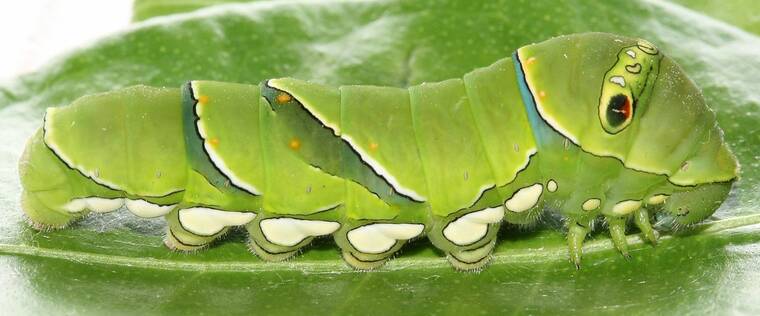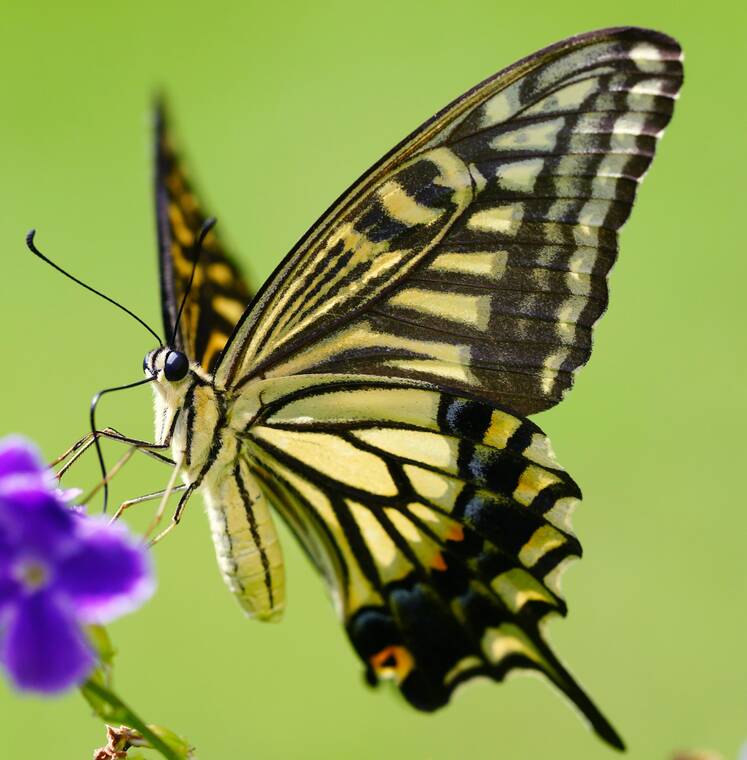If you want to attract butterflies to your property, you need to grow plants they like. The ancient herb rue is an easy to grow woody perennial that can help lure beautiful butterflies to your yard.
Rue was a popular herb in medieval times, known as the herb-of-grace during the Middle Ages. Shakespeare refers to rue in several plays as the “sour herb of grace”. Today, in addition to its long list of historical uses we can add butterfly magnet to its favorable characteristics.
A member of the Rutaceae or Citrus family, rue takes part of its botanical name, Ruta graveolens from the family name. Rue is certainly not as popular as her citrus tree cousins and definitely not as tall or as woody. Since classification is done by the sexual parts of the plants, rue’s fruit that resembles a tiny segmented orange may be the key to her membership in this large family.
The species name greaveolens is Latin for “having a strong or offensive smell.” The leaves of rue plants do have a strong aroma that is offensive to some people as well as to dogs, cats and insects. The leaves are often used as a repellent.
Care should be taken when handling the leaves, however, as they can cause an allergic rash in some people that is made worse in hot sun. These same leaves are the primary host for the Asian swallowtail butterfly (Papilio xuthus). The adult lays eggs on the rue leaves. When their caterpillars hatch, they eat the foliage, grow, pupate and become another beautiful butterfly.
Rue is indigenous to parts of southern Europe and was prized in both the Greek and Roman empires. It was commonly grown and consumed for its bitter flavor that was thought to have medicinal properties including stimulating the digestive system. Rue was also used to provide protection from the plague as well as from evil witches and poisonous potions. As threats from poisonous potions, the plague and witches diminished, rue’s popularity declined.
Today, rue often provides an attractive addition to an herb garden where it offers culinary and medicinal uses as well butterfly appeal. It is small shrub-like plant that can grow to around three feet tall and just as wide. It has small blueish green leaves and puts out sprays of yellow flowers in the longer days of summer. The small fruits that follow flowering are segmented and look like a miniature green orange.
Though its leaves are certainly edible, they are very bitter and have a strong aroma that some find unpleasant. As tastes have changed over the centuries rue’s bitterness and strong aroma, are less appealing today than they once were. Rue leaves are still used in salads, egg dishes and cheeses throughout the Mediterranean, however. They are also used to impart a slight bitterness to tomato sauces. A few rue leaves are used to add a slight citrusy flavor to some Ethiopian coffee recipes.
Dried rue leaves have historically been made into smudge sticks to burn as an insect repellent or for general cleansing. Sprigs of rue leaves are sometimes used by Catholic priests to sprinkle holy water on worshippers seeking repentance. It is the leaves of the rue plant that were used as the model for the suit of clubs in playing cards.
Recipes for the ancient cure-all ‘four thieves vinegar’ are still available. Most include rue. The four thieves were grave robbers during the plague who never contracted the disease. Their parents were herbalists who made a vinegar with garlic and herbs that seemed to protect the brothers from the plague. Today, it is used for protection and healing. More on this is available on the internet.
Centuries of traditional use and anecdotal evidence include many uses for the rue plant. It was used by Leonardo da Vici and Michelangelo to improve their eyesight and their creativity. The leaves also have antifungal properties. Herbalists often recommended using rue tea as a remedy for dizziness, headaches, anxiety and general tension. A tea made from small quantities of the fresh or dry leaves can help to calm the nerves and boost the appetite.
Rue can be easily propagated from cuttings or from seeds. Cuttings will root in water or in a mix of moist vermiculite and perlite. Seeds that form following flowering should be collected when dry. Place them on top of a seeding mix as they germinate best in full sun.
The plants can be grown in the garden or in a pot. They will do best in full sun though they can tolerate partial shade. Though they will grow in poor soil, it must drain well. Once established rue plants are drought tolerant.
Rue requires very little maintenance. Occasional pruning can help control growth and maintain a desired size and shape. Insects are not usually attracted to rue and diseases are rare. A little fertilizer every few months will help the plant thrive.
I found a rue plant among the herbs in a local nursery. You might want to call around to see who has them. According to an old English saying about regret, you may “rue the day” that you don’t include a rue plant in your garden.
Diana Duff is a plant adviser, educator and consultant living part time in Kailua-Kona.
Gardening Events
Saturdays: “Work Day at Amy Greenwell Garden,” 9 a.m. to 12:30 p.m. Meet at the Garden Visitor Center across from the Manago Hotel in Captain Cook. Come with a mask and be prepared to practice social distancing. Volunteers can help with garden maintenance and are invited to bring a brown bag lunch. Water and snacks provided. Visit the website www.amygreenwell.garden/get-involved/volunteer-1/ and sign up for the weekly email for more information on work days.
Saturday, August 6: “Hawaii Tropical Fruit Growers“ Talking about tools. Starting at 10 am at the HTFG office, 81-6393 Mamalahoa Highway. Tony from All tools will explain how to keep power tools in top shape and show the latest battery and gas-powered tools. Free. Members and guests are encouraged to bring fruit for sharing. Non-members are welcome to attend. The HTFG office is a white wooden building on the makai side across from the Department of Transportation yard. Park in front or on the north side. For more information, contact Ken Love at hawaiifruit@gmail.com.
Ongoing: Greenwell Farms coffee leaf rust resistant tree replacement program for Kona coffee cherry farmers who sell to Greenwell Farms or will sign a contract to sell to them. Resistant trees are also for sale. Contact their Administrative Office at 808) 323-9616 for more information.
Soil and Plant Tissue Analyses available now
The Agricultural Diagnostic Service Center (ADSC) is again offering the full suite of Soil and Plant Tissue analyses. Contact Agricultural Diagnostic Service Center, University of Hawai’i at Manoa, 1910 East West Road, Sherman Lab 134, Honolulu or call 808-956-6706
Farmer direct markets
(check websites for the latest hours and online markets)
Wednesday: “Ho’oulu Farmers Market” at Outrigger Kona Resort & Spa at Keauhou Bay
Saturday: “Keauhou Farmers Market” 8 a.m. to noon at Keauhou Shopping Center
Information on their online market: keauhoufarmersmarket.com/onlinemarket
“Kamuela Farmer’s Market” 7:30 a.m. to noon at Pukalani Stables
“Waimea Town Market” 7:30 a.m. to noon at the Parker School in central Waimea
“Waimea Homestead Farmers Market” 7:30 a.m. to noon at the Waimea middle and elementary school playground
Sunday: “Pure Kona Green Market” 9 a.m. to 2 p.m. at Amy Greenwell Garden in Captain Cook
“Hamakua Harvest” 9 a.m. to 2 p.m. at Highway 19 and Mamane Street in Honoka’a
Plant Advice Lines
Anytime: konamg@ctahr.hawaii.edu; Tuesdays and Thursdays from 9 a.m. to noon at UH-CES in Kainaliu at (808) 322-4893. Walk-in from 9 a.m. to noon Mondays, Tuesdays, and Fridays at the UH-CES at Komohana in Hilo or call (808) 981-5199 or email himga@hawaii.edu





